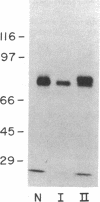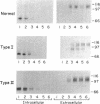Abstract
Patients with hereditary angioneurotic edema (HANE) have serum levels of functionally active inhibitor of the first component of complement (C1 INH) between 5 and 30% of normal, instead of the 50% expected from the single normal allele. Increases in rates of catabolism have been documented in patients with HANE and certainly account for some of decrease in C1 INH level. A possible role for a decrease in synthesis of C1 INH in producing serum levels of C1 INH below the expected 50% of normal has not been well studied. We studied the synthesis of C1 INH in skin fibroblast lines, which produce easily detectable amounts of C1 INH. In type I HANE cells, C1 INH synthesis was 19.6 +/- 4.0% (mean +/- SD) of normal, much less than the 50% predicted. In type II HANE cells, the total amount of C1 INH synthesis (functional and dysfunctional) was 98.9 +/- 17% of normal; the functional protein comprised 43% of the total. Thus, type II HANE cells synthesized functional C1 INH at a much greater rate than for the type I cells. In both type I and II HANE cells, amounts of steady-state C1 INH mRNA levels paralleled rates of C1 INH synthesis, indicating that control of C1 INH synthesis occurred at pretranslational levels. Both type I and type II fibroblasts synthesized normal amounts of C1r and C1s. These data suggest that the lower than expected amounts of functionally active C1 INH in type I HANE may be due, in part, to a decrease in rate of synthesis of the protein, and that the expressions of the normal C1 INH allele in HANE is influenced by the type of abnormal allele present.
Full text
PDF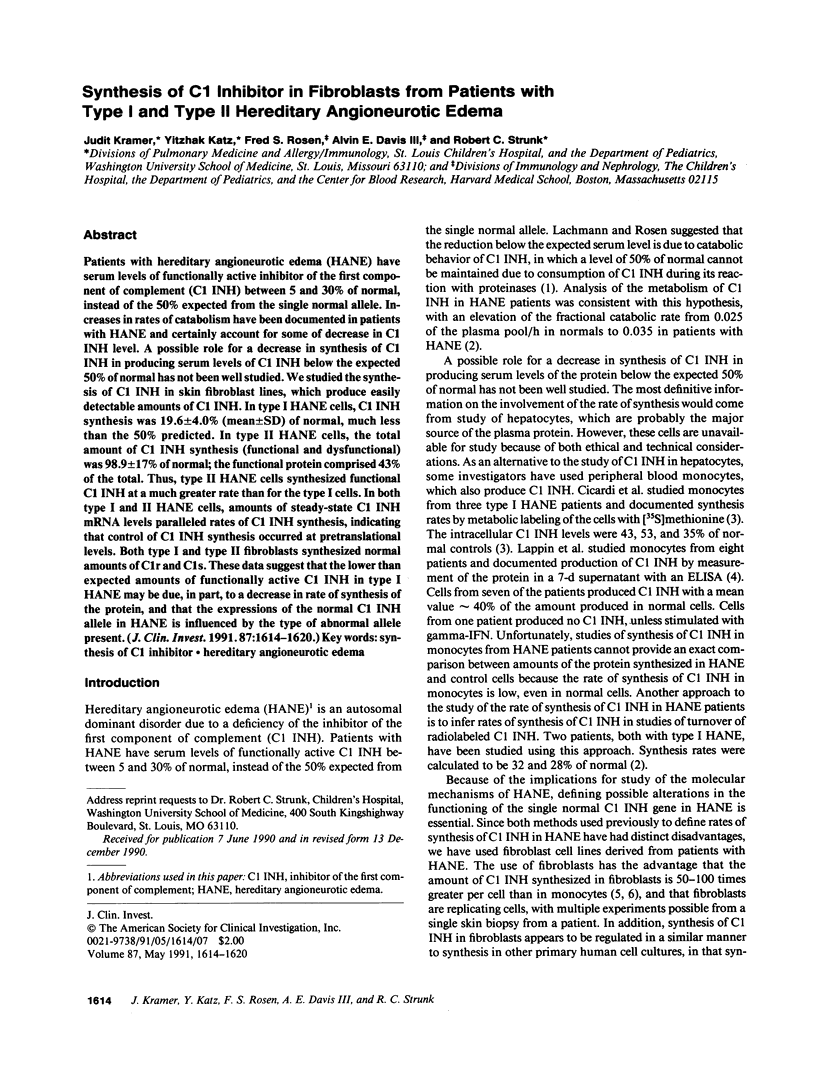
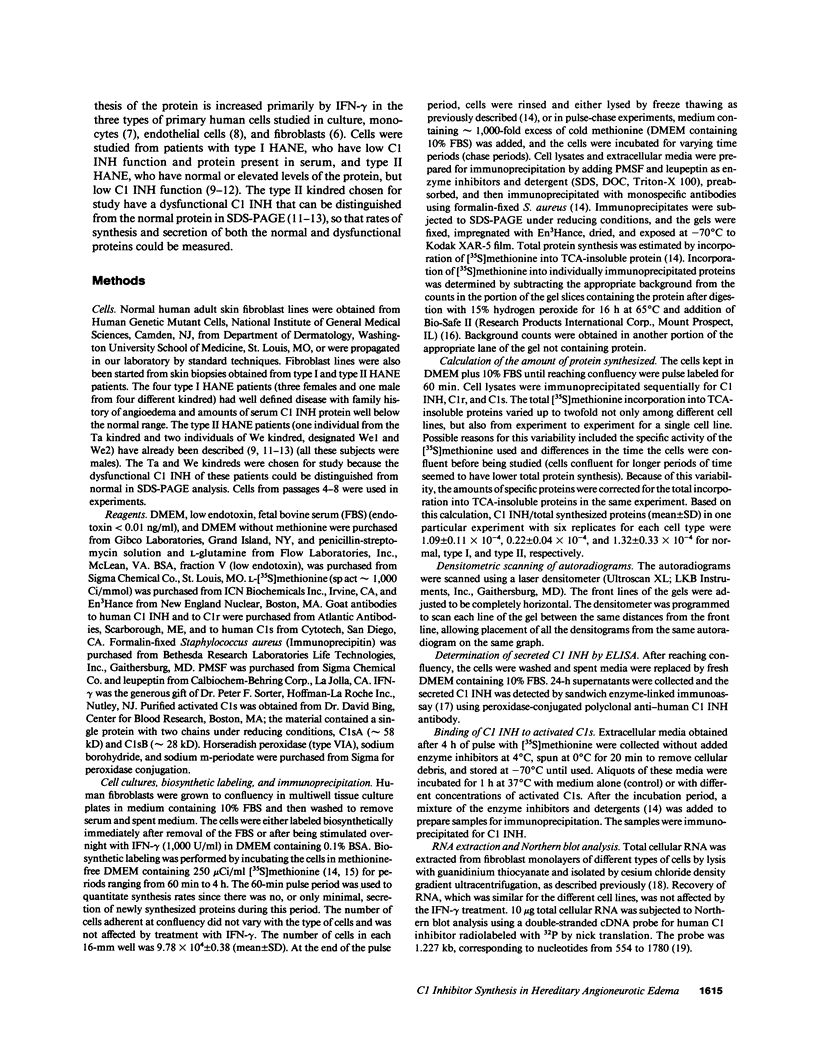
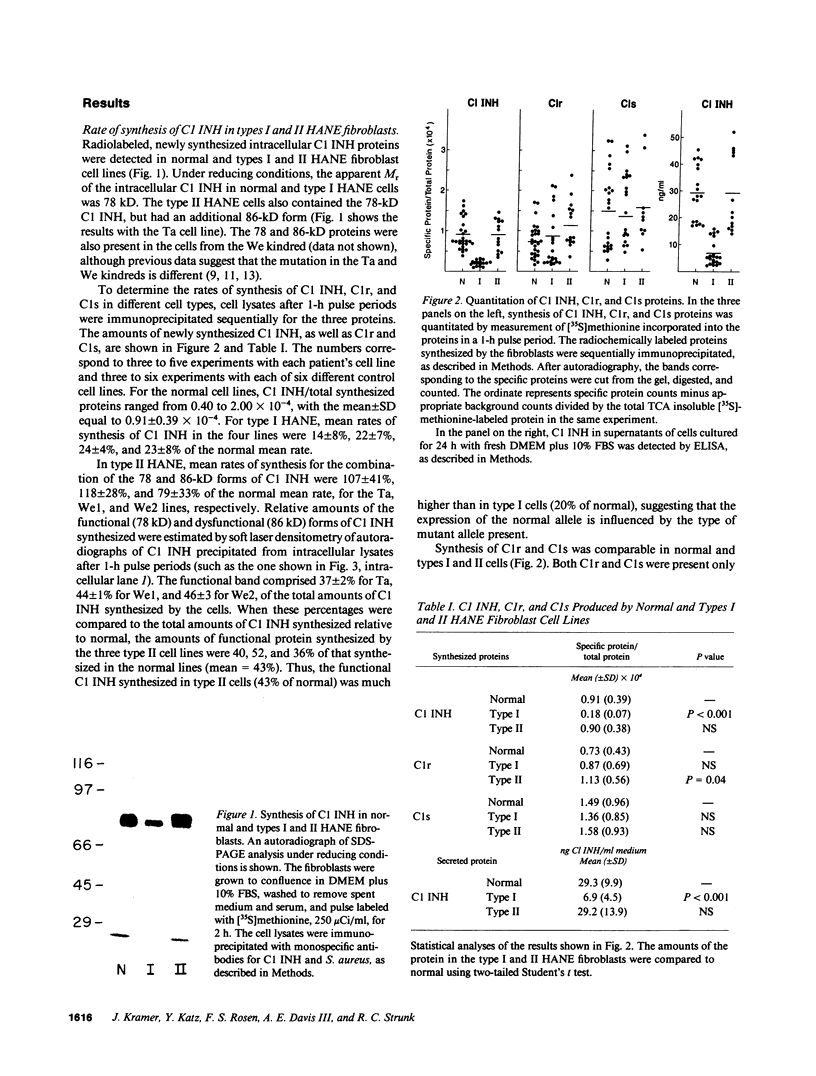
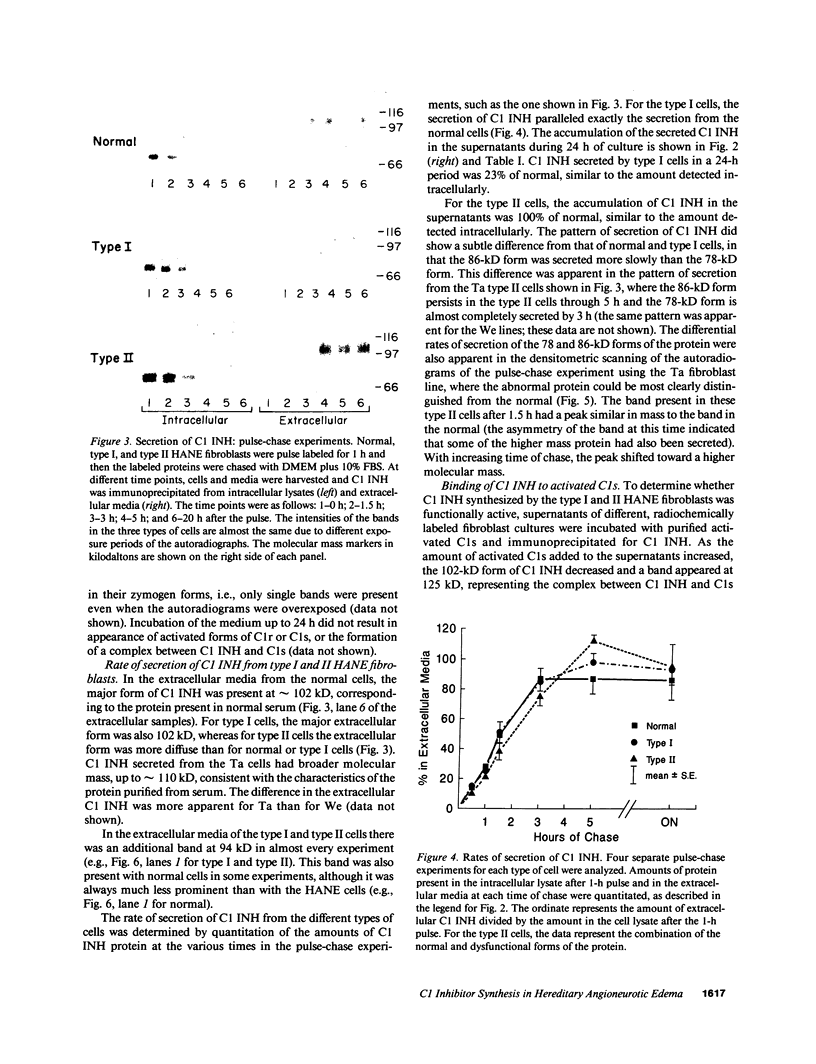
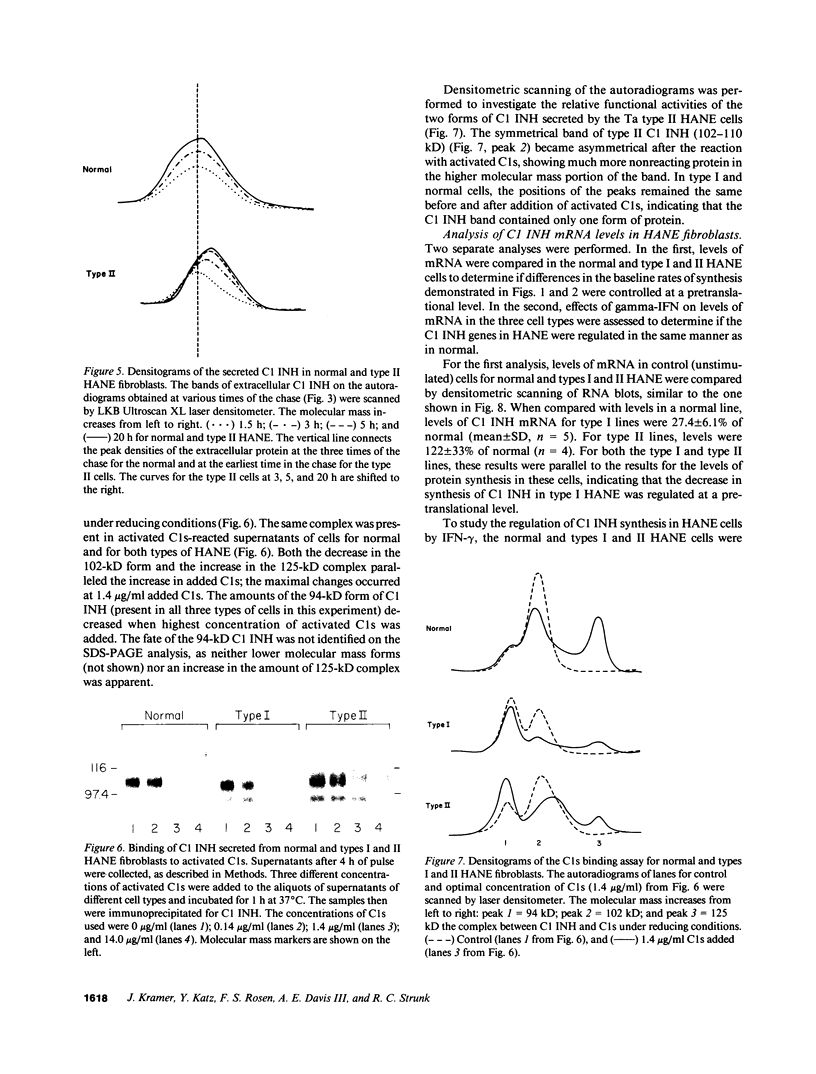
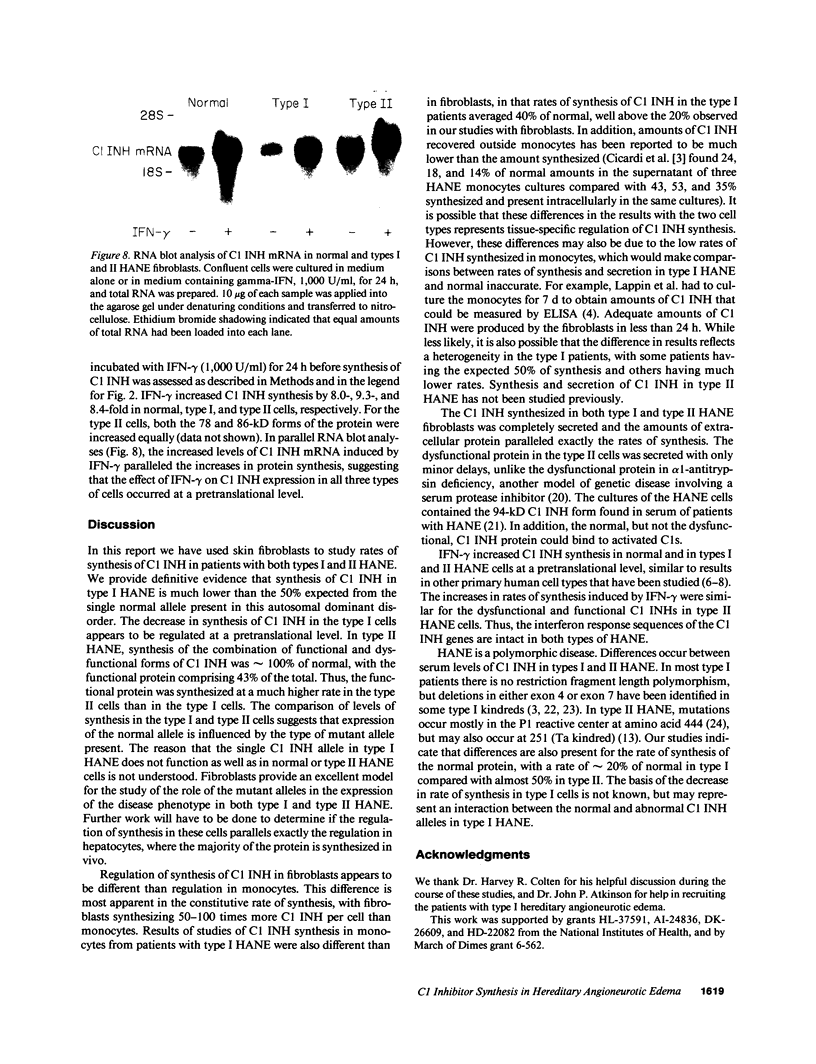
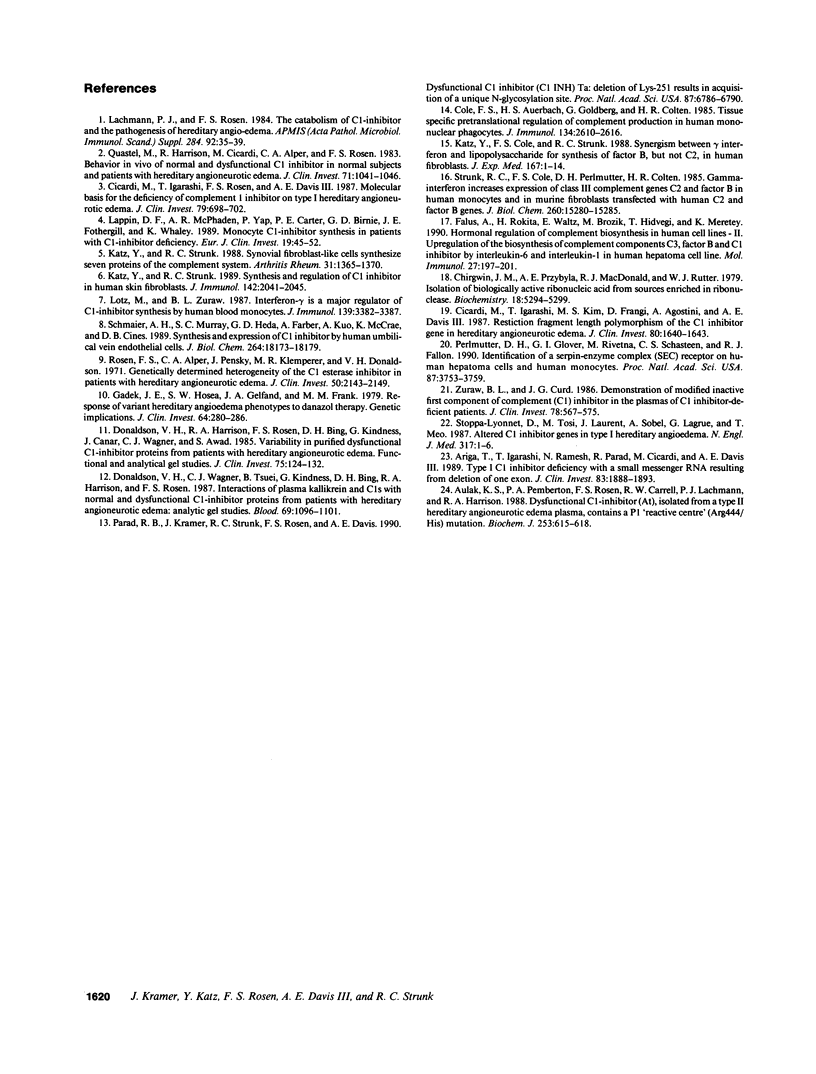
Images in this article
Selected References
These references are in PubMed. This may not be the complete list of references from this article.
- Ariga T., Igarashi T., Ramesh N., Parad R., Cicardi M., Davis A. E., 3rd Type I C1 inhibitor deficiency with a small messenger RNA resulting from deletion of one exon. J Clin Invest. 1989 Jun;83(6):1888–1893. doi: 10.1172/JCI114095. [DOI] [PMC free article] [PubMed] [Google Scholar]
- Aulak K. S., Pemberton P. A., Rosen F. S., Carrell R. W., Lachmann P. J., Harrison R. A. Dysfunctional C1-inhibitor(At), isolated from a type II hereditary-angio-oedema plasma, contains a P1 'reactive centre' (Arg444----His) mutation. Biochem J. 1988 Jul 15;253(2):615–618. doi: 10.1042/bj2530615. [DOI] [PMC free article] [PubMed] [Google Scholar]
- Chirgwin J. M., Przybyla A. E., MacDonald R. J., Rutter W. J. Isolation of biologically active ribonucleic acid from sources enriched in ribonuclease. Biochemistry. 1979 Nov 27;18(24):5294–5299. doi: 10.1021/bi00591a005. [DOI] [PubMed] [Google Scholar]
- Cicardi M., Igarashi T., Kim M. S., Frangi D., Agostoni A., Davis A. E., 3rd Restriction fragment length polymorphism of the C1 inhibitor gene in hereditary angioneurotic edema. J Clin Invest. 1987 Dec;80(6):1640–1643. doi: 10.1172/JCI113252. [DOI] [PMC free article] [PubMed] [Google Scholar]
- Cicardi M., Igarashi T., Rosen F. S., Davis A. E., 3rd Molecular basis for the deficiency of complement 1 inhibitor in type I hereditary angioneurotic edema. J Clin Invest. 1987 Mar;79(3):698–702. doi: 10.1172/JCI112873. [DOI] [PMC free article] [PubMed] [Google Scholar]
- Cole F. S., Auerbach H. S., Goldberger G., Colten H. R. Tissue-specific pretranslational regulation of complement production in human mononuclear phagocytes. J Immunol. 1985 Apr;134(4):2610–2616. [PubMed] [Google Scholar]
- Donaldson V. H., Harrison R. A., Rosen F. S., Bing D. H., Kindness G., Canar J., Wagner C. J., Awad S. Variability in purified dysfunctional C1(-)-inhibitor proteins from patients with hereditary angioneurotic edema. Functional and analytical gel studies. J Clin Invest. 1985 Jan;75(1):124–132. doi: 10.1172/JCI111664. [DOI] [PMC free article] [PubMed] [Google Scholar]
- Donaldson V. H., Wagner C. J., Tsuei B., Kindness G., Bing D. H., Harrison R. A., Rosen F. S. Interactions of plasma kallikrein and C1-s with normal and dysfunctional C1(-)-inhibitor proteins from patients with hereditary angioneurotic edema: analytic gel studies. Blood. 1987 Apr;69(4):1096–1101. [PubMed] [Google Scholar]
- Falus A., Rokita H., Walcz E., Brozik M., Hidvégi T., Merétey K. Hormonal regulation of complement biosynthesis in human cell lines--II. Upregulation of the biosynthesis of complement components C3, factor B and C1 inhibitor by interleukin-6 and interleukin-1 in human hepatoma cell line. Mol Immunol. 1990 Feb;27(2):197–201. doi: 10.1016/0161-5890(90)90115-g. [DOI] [PubMed] [Google Scholar]
- Gadek J. E., Hosea S. W., Gelfand J. A., Frank M. M. Response of variant hereditary angioedema phenotypes to danazol therapy. Genetic implications. J Clin Invest. 1979 Jul;64(1):280–286. doi: 10.1172/JCI109449. [DOI] [PMC free article] [PubMed] [Google Scholar]
- Katz Y., Cole F. S., Strunk R. C. Synergism between gamma interferon and lipopolysaccharide for synthesis of factor B, but not C2, in human fibroblasts. J Exp Med. 1988 Jan 1;167(1):1–14. doi: 10.1084/jem.167.1.1. [DOI] [PMC free article] [PubMed] [Google Scholar]
- Katz Y., Strunk R. C. Synovial fibroblast-like cells synthesize seven proteins of the complement system. Arthritis Rheum. 1988 Nov;31(11):1365–1370. doi: 10.1002/art.1780311104. [DOI] [PubMed] [Google Scholar]
- Katz Y., Strunk R. C. Synthesis and regulation of C1 inhibitor in human skin fibroblasts. J Immunol. 1989 Mar 15;142(6):2041–2045. [PubMed] [Google Scholar]
- Lachmann P. J., Rosen F. S. The catabolism of C1(-)-inhibitor and the pathogenesis of hereditary angio-edema. Acta Pathol Microbiol Immunol Scand Suppl. 1984;284:35–39. [PubMed] [Google Scholar]
- Lappin D. F., McPhaden A. R., Yap P. L., Carter P. E., Birnie G. D., Fothergill J. E., Whaley K. Monocyte C1-inhibitor synthesis in patients with C1-inhibitor deficiency. Eur J Clin Invest. 1989 Feb;19(1):45–52. doi: 10.1111/j.1365-2362.1989.tb00194.x. [DOI] [PubMed] [Google Scholar]
- Lotz M., Zuraw B. L. Interferon-gamma is a major regulator of C1-inhibitor synthesis by human blood monocytes. J Immunol. 1987 Nov 15;139(10):3382–3387. [PubMed] [Google Scholar]
- Parad R. B., Kramer J., Strunk R. C., Rosen F. S., Davis A. E., 3rd Dysfunctional C1 inhibitor Ta: deletion of Lys-251 results in acquisition of an N-glycosylation site. Proc Natl Acad Sci U S A. 1990 Sep;87(17):6786–6790. doi: 10.1073/pnas.87.17.6786. [DOI] [PMC free article] [PubMed] [Google Scholar]
- Perlmutter D. H., Glover G. I., Rivetna M., Schasteen C. S., Fallon R. J. Identification of a serpin-enzyme complex receptor on human hepatoma cells and human monocytes. Proc Natl Acad Sci U S A. 1990 May;87(10):3753–3757. doi: 10.1073/pnas.87.10.3753. [DOI] [PMC free article] [PubMed] [Google Scholar]
- Quastel M., Harrison R., Cicardi M., Alper C. A., Rosen F. S. Behavior in vivo of normal and dysfunctional C1 inhibitor in normal subjects and patients with hereditary angioneurotic edema. J Clin Invest. 1983 Apr;71(4):1041–1046. doi: 10.1172/JCI110831. [DOI] [PMC free article] [PubMed] [Google Scholar]
- Rosen F. S., Alper C. A., Pensky J., Klemperer M. R., Donaldson V. H. Genetically determined heterogeneity of the C1 esterase inhibitor in patients with hereditary angioneurotic edema. J Clin Invest. 1971 Oct;50(10):2143–2149. doi: 10.1172/JCI106708. [DOI] [PMC free article] [PubMed] [Google Scholar]
- Schmaier A. H., Murray S. C., Heda G. D., Farber A., Kuo A., McCrae K., Cines D. B. Synthesis and expression of C1 inhibitor by human umbilical vein endothelial cells. J Biol Chem. 1989 Oct 25;264(30):18173–18179. [PubMed] [Google Scholar]
- Stoppa-Lyonnet D., Tosi M., Laurent J., Sobel A., Lagrue G., Meo T. Altered C1 inhibitor genes in type I hereditary angioedema. N Engl J Med. 1987 Jul 2;317(1):1–6. doi: 10.1056/NEJM198707023170101. [DOI] [PubMed] [Google Scholar]
- Strunk R. C., Cole F. S., Perlmutter D. H., Colten H. R. gamma-Interferon increases expression of class III complement genes C2 and factor B in human monocytes and in murine fibroblasts transfected with human C2 and factor B genes. J Biol Chem. 1985 Dec 5;260(28):15280–15285. [PubMed] [Google Scholar]
- Zuraw B. L., Curd J. G. Demonstration of modified inactive first component of complement (C1) inhibitor in the plasmas of C1 inhibitor-deficient patients. J Clin Invest. 1986 Aug;78(2):567–575. doi: 10.1172/JCI112610. [DOI] [PMC free article] [PubMed] [Google Scholar]



